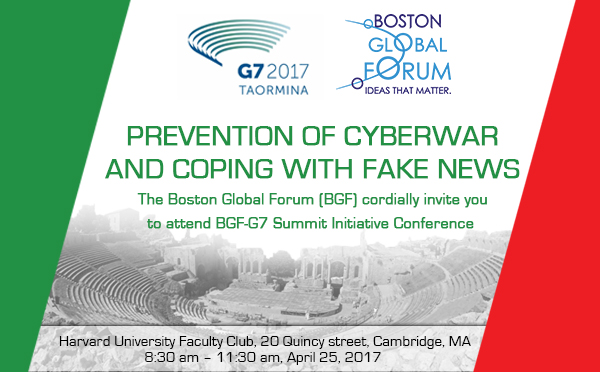Today’s News…Who Do You Trust?
By Kirk Hazlett, APR, Fellow PRSA
It’s frustrating enough these days to keep tabs on world events, and an emerging challenge has added a new dimension to that frustration…what is the origin of the news and information that you get from traditional as well as online sources?
Communication experts from around the world gathered recently in Cambridge, Mass., to share thoughts, experiences, and best practices in combatting cyber-attacks and (often closely related) “fake news” as part of the Boston Global Forum–G7 Summit Initiative Conference.
Following an introduction by former Massachusetts Governor and Chairman of Boston Global Forum Michael Dukakis, Nicola De Santis, Consul General of Italy in Boston, set the background for the morning’s discussions by noting, “We are laying the groundwork today to address the challenges of today’s societies.” De Santis went on to say that proceedings of the symposium will be presented for inclusion at the 43rd G7 Summit in Taormina, Italy.
As a veteran public relations professional now teaching the next generation(s) of PR pros, I found myself fascinated by…and concerned about…the channels through which often unsuspecting citizens receive what they believe to be news and information. More to the point, I found myself wondering how I and my colleagues, both professional and academic, can best prepare these future communicators to determine what is “fact” and what is “hacked.”
As the morning progressed, it became abundantly clear that the burden of proof lies squarely on the shoulders of the consumer. No longer can we rely solely on the traditional “gatekeepers” whose responsibility it is to ensure that what is being communicated to their audiences is verifiable and valid. The term “citizen journalist” has evolved as social media has become the dominant means of relaying news and information, and that “journalist” more often than not relies on his or her own “sources” for that news.
Canadian professor/philosopher Marshall McLuhan famously said, “The medium is the message.” But, as is becoming more and more apparent, that medium can also be manipulated. Symposium participant Trey Herr, Cybersecurity Fellow at Harvard University’s John F. Kennedy School of Government, summed the dilemma up by saying, “The bigger piece of the puzzle is how do I trust the system that I am using?”
Therein lies the greater challenge for current…and more importantly…for future communicators. As cyber warfare escalates from individual computer system hackers who, for varied reasons, choose to manipulate information, to governments, how does one verify both the information itself and the source of that information?
According to Mikko Hypponen, Chief Research Officer for Finnish cyber security and privacy company F-Secure, while criminal hackers are the largest in sheer numbers, government hackers “are much more serious. Although they are not so big in numbers, they have the capabilities and the resources [not available to individual criminal hackers].”
Once again the question bubbles up in my mind, “How to differentiate between fact and fiction if one’s own government is manipulating the information that is being communicated to its all-too-trusting citizens? And how do I, as an educator, help my students understand that erring on the side of caution must become second-nature to them as they pursue their career as communicators? How to recognize ‘fake news’?”
The phrase “fake news” has rapidly become as commonplace today as “rock-and-roll” was for my generation. As pointed out by Harvard University’s Global Citizenship Education Network Professor Thomas Patterson, “During the recent political campaign, fake news topped mainstream news in believability by the public.” And that “success” has been achieved through such tried and proven motivational techniques as repetition of message and reinforcement of beliefs.
As a former member of the Public Relations Society of America’s Board of Ethics and Professional Standards, I was encouraged that the matter of ethics in communication was raised as part of the “fake new” discussion. In particular, the responsibility of institutions of higher education to implement fact-checking mechanisms and initiatives into their curriculum to instill in future communicators as well as business leaders the importance of honest and open communication as part and parcel of a democratic society.
My personal and reassuring take-away from the Boston Global Forum-G7 Summit Initiative Conference was that there is a recognition that cyber warfare is a serious threat to the ability of citizens of any country to remain educated and informed about events of significance to their own existence and that of generations to come, with fake news rapidly becoming a serious threat to that awareness.
My challenge, as an educator, is to help my students understand the role that they will play as communicators.
Ivy Ledbetter Lee, arguably the “Father of Ethical Public Relations,” said it best in his “Declaration of Principles” in 1906: “In brief, our plan is frankly, and openly, on behalf of business concerns and public institutions, to supply the press and public of the United States prompt and accurate information concerning subjects which it is of value and interest to the public to know about.”
Kirk Hazlett, APR, Fellow PRSA, is Assistant Professor of Communication/Public Relations at Curry College in Milton, MA
